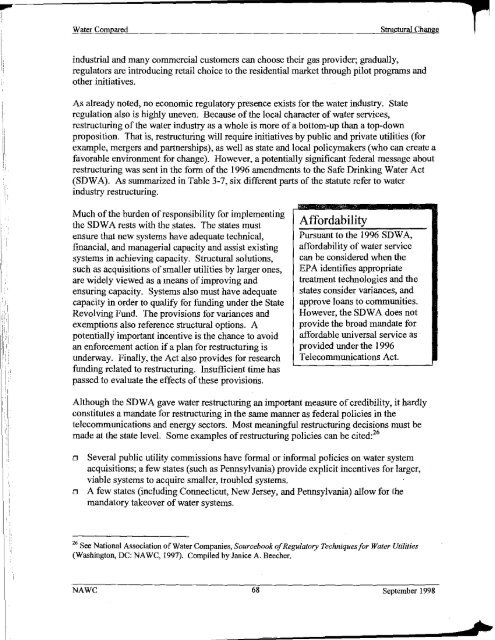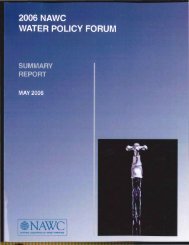BEECHER - NAWC
BEECHER - NAWC
BEECHER - NAWC
You also want an ePaper? Increase the reach of your titles
YUMPU automatically turns print PDFs into web optimized ePapers that Google loves.
Water ComparedStructural Changeindustrial and many commercial customers can choose their gas provider; gradually,regulators are introducing retail choice to the residential market through pilot programs andother initiatives.As already noted, no economic regulatory presence exists for the water industry. Stateregulation also is highly uneven. Because of the local character of water services,restructuring of the water industry as a whole is more of a bottom-up than a top-downproposition. That is, restructuring will require initiatives by public and private utilities (forexample, mergers and partnerships), as well as state and local policymakers (who can create afavorable environment for change). However, a potentially significant federal message aboutrestructuring was sent in the form of the 1996 amendments to the Safe Drinking Water Act(SDWA). As summarized in Table 3-7, six different parts of the statute refer to waterindustry restructuring.Much of the burden of responsibility for implementingthe SDW A rests with the states. The states mustensure that new systems have adequate technical,financial, and managerial capacity and assist existingsystems in achieving capacity. Structural solutions,such as acquisitions of smaller utilities by larger ones,are widely viewed as a means of improving andensuring capacity. Systems also must have adequatecapacity in order to qualify for funding under the StateRevolving Fund. The provisions for variances andexemptions also reference structural options. Apotentially important incentive is the chance to avoidan enforcement action if a plan for restructuring isunderway. Finally, the Act also provides for researchfunding related to restructuring. Insufficient tirue haspassed to evaluate the effects of these provisions.AffordabilityPursuant to the 1996 SDW A,affordability of water servicecan be considered when theEPA identifies appropriatetreatment technologies and thestates consider variances, andapprove loans to communities.However, the SDW A does notprovide the broad mandate foraffordable universal service asprovided under the 1996Telecommunications Act.Although the SDW A gave water restructuring an important measure of credibility, it hardlyconstitutes a mandate for restructuring in the same manner as federal policies in thetelecommunications and energy sectors. Most meaningful restructuring decisions must bemade at the state level. Some examples of restructuring policies can be cited: 26ooSeveral public utility commissions have formal or informal policies on water systemacquisitions; a few states (such as Pennsylvania) provide explicit incentives for larger,viable systems to acquire smaller, troubled systems.A few states (including Connecticut, New Jersey, and Pennsylvania) allow for themandatory takeover of water systems.26See National Association of Water Companies, Sourcebook of Regulatory Techniques for Water Utilities(Washington, DC: <strong>NAWC</strong>, 1997). Compiled by Janice A. Beecher.<strong>NAWC</strong> 68_______________________September 1998_.
















